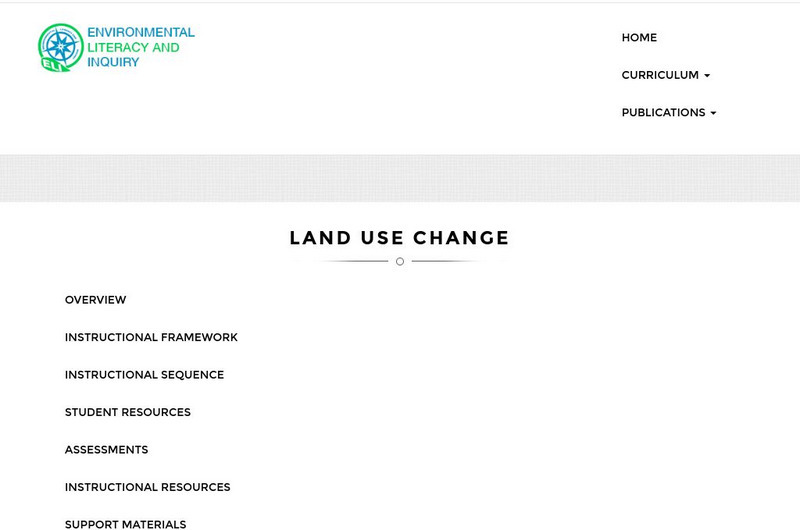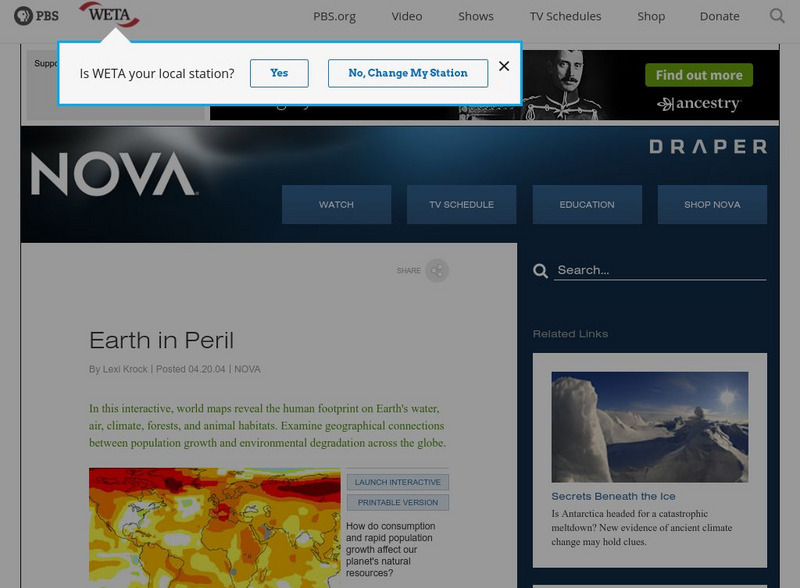Hi, what do you want to do?
Science Education Resource Center at Carleton College
Serc: Using Plant Surveys to Study Biodiversity
An extended field investigation intended as launch into several concepts in environmental science including biodiversity, human impacts on natural systems, and energy transfer in ecosystems.
Scholastic
Scholastic: Study Jams! Science: Ecosystems: Changes in Ecosystems
A video and a short multiple-choice quiz on the natural changes that take place in an ecosystem, and the negative impact humans can have on ecosystems.
Population Connection
Population Connection: Population and Environment[pdf]
A paper from the Population Connection that outlines the consequences to the environment if humans continue on the path of overpopulation.
NOAA
Noaa: National Ocean Service Education: Estuaries
Illustrated tutorial explains estuary ecosystems. Animations and illustrations help students become more familiar with the plant and animal communities which make up this coastal habitat.
Smithsonian Institution
National Museum of Natural History: Ocean Portal: Corals and Coral Reefs
Learn about corals and the importance of coral reefs to ocean ecosystems. Find out how reefs are created, what threats they face, and what kinds of conservation tactics are being used to protect and preserve them.
Polk Brothers Foundation Center for Urban Education at DePaul University
De Paul University: Center for Urban Education: Changing the Ecosystem: Q & a [Pdf]
"Changing the Ecosystem: Q & A" is a one page, nonfiction, reading passage about how the loss of the prairie to farming and population growth impacts the ecosystem. It is followed by questions which require students to provide...
Georgia Department of Education
Ga Virtual Learning: Ap Biology: Ecology
Students review the study of living things and make connections back to Earth's systems. This unit focuses on how various species, grouped in populations and communities, work with the nonliving things around them to ensure survival.
Nature Conservancy
Nature Conservancy: Planet Earth: Oceans and Coasts
Compilation of the Nature Conservancy's content about the ecology of oceans and coasts. Emphasis is on the biodiversity of these habitats and the human impact on the animal and plant life that live in our oceans and on our coasts.
National Geographic
National Geographic: Programs: Chesapeake Bay Water Quality Project
A project-based collaborative unit of study that teaches students about watershed health using real-time geospatial technology. Students engage in outdoor field experiences while using twenty-first century learning skills.
Environmental Education for Kids
Eek!: Community Action & Citizen Science: Biomonitoring
Biomonitoring is the term scientists use to describe the use of plants, animals, or entire ecosystems to tell if our environment is polluted. Biomonitoring has been used by biologists and scientists to give us information about our...
Other
Florida Department of Environmental Protection: Climate Change and Coral Reefs
Find out about the devastating effects climate change is having on Florida's coral reef ecosystems.
National Geographic
National Geographic: Ocean Abiotic Factors
After looking at examples of biotic and abiotic factors in ecosystems, students focus on abiotic factors in marine ecosystems, the physical processes that are involved, and the impact human activities can have on these. Includes handouts...
National Wildlife Federation
National Wildlife Federation: Invasive Species
This site explains what invasive species are and how widespread and detrimental their impact is on an ecosystem, on wildlife, and on humans. The methods by which they can travel are listed, and examples of invasive species are given. The...
Annenberg Foundation
Annenberg Learner: The Habitable Planet: Unit 9: Biodiversity Decline
This is an extensive learning module on biodiversity and its decline. It looks at ways biodiversity is threatened, the possibility of another mass extinction, the causes and consequences of habitat loss, factors that drive biodiversity...
Annenberg Foundation
Annenberg Learner: The Habitable Planet: Water Resources
Learn about water as a precious resource in danger of being depleted. Understand the roles that overuse and agricultural use play in the sustainability efforts of this essential resource. Includes video. [28:25]
Other
Cefas: Our Science
A website focusing on the research done by the Center for Environment, Fisheries, and Aquaculture science that focuses on climate change, marine planning, fisheries management, and sustainability. Website includes information about...
Science Struck
Science Struck: The Amazon Rainforest Climate
Describes the ecology of the Amazon rainforest, the characteristics of its climate, the impact of human actions on this environment and the need for stronger conservation efforts to save the rainforests.
European Union
European Environment Agency: Nature and Wildlife
This site has the summary of a report on nature and wildlife in Europe. Read about the natural environment, changes resulting from human activity, or access a table of contents to read more.
Other
Lehigh University: Land Use Change
An inquiry-based science unit for middle school students centered on how human activities affect environmental changes related to land use. The lessons integrate technology and lab activities while teaching about today's land use and how...
Globio
Glossopedia: Environments
This article defines "environment" as a collection of animals and plants in a specific landscape and climate. The concept of differing types of environments is introduced. The impact of humans on environments and all environments'...
Other
West Virginia University Extension Service: Overgrazing Can Hurt Environment
This short article describes problems associated with improper farm management with regard to livestock overgrazing. Includes grazing management guidelines for healthy and productive pastures.
Regents of the University of Michigan
Animal Diversity Web: Wolverine
Comprehensive reference material on the wolverine, with information on its habitat, physical features, diet, reproduction, behavior, communication, role in its ecosystem, economic impact on humans, and conservation status.
PBS
Nova: Earth in Peril
A series of nine maps with accompanying explanations. They show how population growth has affected the environment around the world in terms of water availability, climate change, land and forest use, and more. There are both interactive...
US Geological Survey
Usgs: Earth Surface Dynamics (Research Activities)
This site from USGS provides several activities to help understand the interrelationships among earth surface processes, ecological systems, and human activities. Also included are links to new findings and programs concerning Earth...







![Population Connection: Population and Environment[pdf] Article Population Connection: Population and Environment[pdf] Article](https://static.lp.lexp.cloud/images/attachment_defaults/resource/large/FPO-knovation.png)












